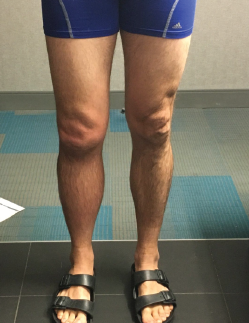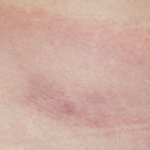
Photo 3: The patient has obvious swelling in the right knee.
The initial treatment of Lyme arthritis per the Infectious Diseases Society of America guideline is oral antibiotics, typically 100 mg of doxycycline twice daily by mouth or 500 mg of amoxicillin three times daily by mouth for a 28-day treatment course.4 In patients with mild persistent arthritis or recurrent synovitis after initial treatment, a second course of oral antibiotics is recommended. For patients with moderate to severe arthritis after 28 days of antibiotic therapy, intravenous (IV) antibiotics, typically IV ceftriaxone, are recommended.
Biomarkers to demonstrate the infection has been cured are currently lacking. Synovial fluid PCR is used by some clinicians to monitor therapy; however, a positive PCR may reflect residual nucleic acid and may not necessarily indicate ongoing active infection. Serum serology may also remain positive for many years after successful treatment of Lyme arthritis, and a positive serology is not a measure of active infection.
A subset, approximately 10%, of patients with Lyme arthritis has ongoing proliferative synovitis despite two to three months of oral and IV antibiotic treatment.5 Histologically, this type of arthritis is similar to other forms of chronic inflammatory arthritis, such as rheumatoid arthritis. Persistent infection has not been demonstrated from synovectomy tissue samples in patients who have received at least two weeks of IV antibiotics as part of their therapy. This condition, called antibiotic-refractory, post-infectious Lyme arthritis, seems to be an immune-mediated process characterized by high levels of interferon gamma and infection-induced autoimmunity. Both host and pathogen factors may influence this outcome.
We treat antibiotic-refractory, post-infectious Lyme arthritis patients with disease-modifying anti-rheumatic drugs (DMARDs), including methotrexate and hydroxychloroquine.6 We have also managed post-infectious Lyme arthritis with tumor necrosis factor (TNF) inhibitors. Intra-articular steroid injections and NSAIDs may also benefit patients with milder cases, and steroid injections have been particularly beneficial in the pediatric population. Synovectomy may also be a therapeutic option for patients with monoarthritis. Patients respond quite well to DMARD therapy without signs of recurrence of infection.
In contrast to rheumatoid arthritis, which requires long-term—often lifetime—treatment, post-infectious Lyme arthritis resolves over time, and long courses of DMARDs are not needed. We typically treat Lyme arthritis patients with DMARDs for only 6–12 months.
Finally, we have seen patients develop other forms of autoimmune arthritis, such as rheumatoid arthritis or spondyloarthropathy, following previously treated Lyme disease, and this possibility can be considered in patients with persistent arthritis despite antibiotic treatment.7
Although post-treatment Lyme syndrome seems to affect patients with early or neurologic Lyme disease more frequently than those with Lyme arthritis, diffuse pain or neurocognitive symptoms despite resolution of inflammatory arthritis would suggest this problem.8
For all patients with Lyme arthritis, physical therapy is an important adjunctive treatment to prevent quadriceps atrophy and preserve function. However, the majority of patients with Lyme arthritis achieve good long-term clinical outcomes.


